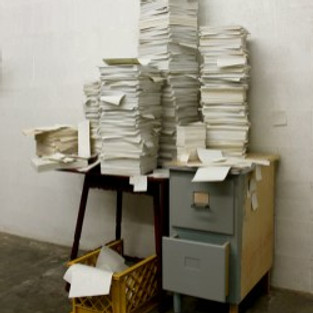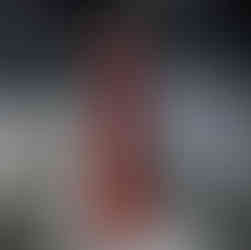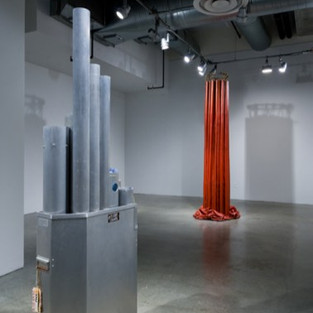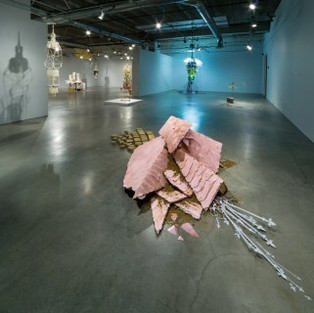
Installation View. Pasadena Museum of California Art. Interstitial. Photo Courtesy of PMCA. Photo Credit Don Milici.
Interstitial at the Pasadena Museum of California Art
The Meaning In-Between
By Lorraine Heitzman
Through August 6th
As a culture we glorify “things”; EBay monetizes our possessions and Instagram fetishizes them. The utilitarian and aesthetic things that surround us fill our lives and our landfills, yet the collectibles, ephemera, household items and building materials in our environment are so ubiquitous that they often become invisible.
In an effort to challenge the way we look at the objects in our lives, John David O’Brien has guest curated Interstitial, one of the current shows at The Pasadena Museum of California Art. The seven artists included in the show use materials in ways that question our assumptions about “things” by placing them in new contexts. Jeff Colson, Renée Lotenero, Kristen Morgin, Joel Otterson, Rebecca Ripple, Aili Schmeltz and Shirley Tse bring humor, irony, and curiosity to the task. Some of the artists in the show utilize common objects in lieu of art materials while others create replicas that contradict and amplify or contradict their original purposes. Interstitial examines different ways that we engage with the material things that surround us with a focus on the shifts of meaning between our expectations and the objects themselves.
Generally speaking, to be a sculptor implies a love of materiality and an attraction, if not affection, towards the man made things in our environment. No one embraces this more than Joel Otterson. His two artworks in the show are loving altars to domestic paraphernalia. The first, American Portable Pottery Museum, is a freestanding display of pottery on wheels, a carnival game of ceramic collectibles ranging in color and kitsch factor. It is large enough to be a room divider and somewhat encyclopedic. Each vase or knick-knack is woven together in a display rack made of copper tubing, constructed in a Rube Goldberg contorted way to ensure the arrangement is permanent and at the same time, mobile. One senses that the artist enjoys his contradictions. Otterson uses humor to critique and display our obsessions not only in the American Portable Pottery Museum but also in Bottoms Up # 3. His glass chandelier, made up of dozens of upturned drinking glasses, may be pun-driven but I suspect it is more a testament to his love for the transformation of common things. Here, inexpensive glassware becomes an object usually associated with great wealth, if not pretense and at the same time, a thing of beauty. In both sculptures Otterson takes our material possessions and turns them into raw materials for his art. Along the way, as we admire or find amusement in the individual piece of pottery and glass, they each surrender to the overall display, one that is ultimately greater than the sum of its parts.
Jeff Colson seems less enthralled with the transformative process than with the narrative potential of objects. In Stacks, the artist created a tableau of a generic table, filing cabinet and crate overwhelmed by stacks of paper. Upon closer examination, nothing is as it appears to be; everything is carefully crafted out of wood, urethane resin, and acrylic; a trompe l’oeil recreation of a memory. What appears as stacks of paper look like they could disperse at any moment, so the tension of that expectation is derailed when it becomes apparent that they are stationary objects. Something happened here and might happen in the future; time is part of this mysterious narrative. Colson’s other sculpture, Draped Column, is fashioned out of fiberglass, steel and acrylic. Standing ten feet tall and suggesting an elegant obelisk as much as a shower curtain, this curious sculpture raises questions: Is this a functional object? What function is implied? The title refers to an architectural element or a memorial, but this totem defies gravity and it unclear what could be memorialized. Instead, it exists as a conundrum, a surreal manifestation of an object of the imagination that shouldn’t be able to exist, but does so with its imposing, tangible presence. Draped Column holds our attention and our curiosity as a fully realized poetic statement.
Aili Schmeltz contributes two very different sorts of work. Brick and Cinderblock are replicas of building materials cast in bronze and exhibited on the gallery floor without any fanfare, as seemingly random artifacts of our culture. More innovative and thought provoking are her two other sculptures: Twisted Hourglass Generator VIII and Twisted Hourglass Generator VI. Looking like ambitious macramé projects gone astray, these were inspired by psionic generators, apparatus believed to harness energy from the eyes to encourage psychic phenomena. Schmeltz explores these forms and melds the quasi-scientific with handicrafts to create objects that place the possibilities of ESP within our reach while elevating macramé from its usual domestic context into machines of our imaginations.

Kristen Morgin. My Lucky Star. Pasadena Museum of California Art. Interstitial. Photo Courtesy of PMCA.
Kristen Morgin brings attention to her installations of nostalgic memorabilia and detritus with the use of her well crafted painted clay facsimiles. My Lucky Star and Hollywoodland both use this conceit and transform what would otherwise be an assemblage of precious and common objects into a chance for the viewer to marvel at the artist’s ability to reinterpret materials, but also question the materiality of each element.
Rebecca Ripple is represented in the show by Cork and Balzac. The former, a painted aluminum and copper twisted strip is suspended from the ceiling and references the metal wrap around wine bottles, albeit in a different scale and out of context. The later is a complex vacuum formed vinyl and aluminum standing sculpture. Balzac has the gestural lines of a figure rooted to the ground, but it is all action above. Lighted with fluorescent tubes that hover closely to the top, the clear vinyl and metal crackle with an intensity that helps animate the sculpture. Where Cork relies on mimicry and scale for effect, Balzac transforms materials into an abstract expression of movement and line.
Shirley Tse’s skill lies in her ability to combine unrelated objects to invest new meanings into her arrangements of various generic-looking parts. Vital Organ Series: Audio is an aluminum airplane trashcan filled with tubes of varying heights to recall a pipe organ. Inside a cut-away in one tube, there is a brilliant yellow interior and sulfur crystal. Vital Organ Series: Geo is a more organic looking piece and less constrained, incorporating metal, moss, rubber, plastic, Plexiglas and found military parts to suggest an instrument of unknown purpose. Delicate, precise and possibly decayed, Tse plays with the notion of function, both past and repurposed.

Renee Lotenero. 3119 Cazador. Pasadena Museum of California Art. Interstitial. Photo Courtesy of PMCA. Photo Credit Don Milici.
Lastly, Renée Lotenero’s Study for 3119 Cazador Street, 3005 Division Street, 3264 Carlyle Street appears to be a deconstruction of several buildings reassembled in a loose configuration onto the floor. Consisting primarily of building materials, such as stucco, decomposed granite and pavers, Lotenero finds many of her materials and photographs that she uses on the streets. This is architecture without any function; an exploded drawing of a former structure, or the plans and raw materials of what it will become.
Objects are part and parcel of our lives but their meanings are always reliant on their context. Through the work of these seven artists, we are asked to question our assumptions regarding our relationships to objects and how they relate to each other. Interstitial brings variety to the investigation with a handsome, thought provoking show.
Interstitial is on view through August 6, 2017 at the Pasadena Museum of California Art
#losangeles #california #losangelesartist #KristenMorgin #art #PMCA #RenéeLotenero #losangelesmuseum #onlineartmagazine #losangelesart #AiliSchmeltz #Interstitial #southerncalifornia #artgallery #PasadenaMuseumofCaliforniaArt #artandcake #contemporarysculpture #installation #ArtandCakeLA #fineart #artists #artist #arts #PasadenaMuseum #artreview #artmuseum #sculpture #artmagazine #JoelOtterson #ShirleyTse #ArtandCulture #RebeccaRipple #JeffColson #losangelesgallery #lorraineheitzman


































